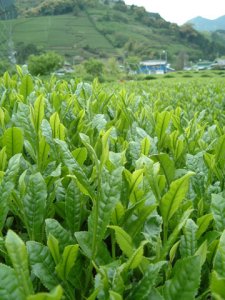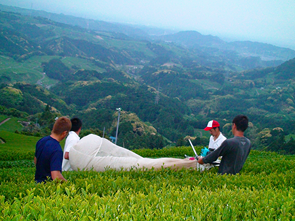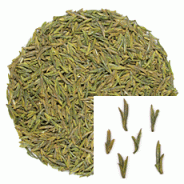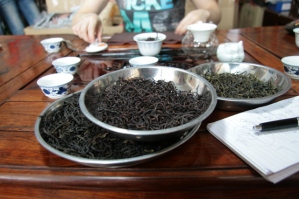Whoohoo….it is fast approaching the new 2016 tea season here at Tea Trekker.
Early spring is an exciting time for us. It is filled with anticipation of the new tea season in China, India, Japan, Korea,Taiwan and Sri Lanka. We eagerly await the moments when we are notified by our tea suppliers that new fresh teas are ready and the samples we requested have been dispatched to us.

The teas we select are then AIR SHIPPED to us in order to obtain these premium teas when they are just 10 days to 2 weeks old. These fresh teas are such a taste treat, and so rarely available for sale in the USA this soon after manufacture. We pride ourselves on being one of the first tea vendors to accomplish this fast availability of fresh new tea.
Seasonality in tea is important. Tea enthusiasts are beginning to understand that many premium Chinese green, white and yellow teas; and Japanese and Korean green teas are plucked only once each year in the early spring.
Other teas, such as hong cha and oolongs may be plucked over the course of two or three seasons. Tea that is plucked once a year is more expensive because the short manufacturing season yields less tea for the farmers and tea villages to sell. But these teas have superior flavors and aromas and more finesse and character than the standard-quality green teas that are plucked during the summer months, so tea lovers seek them out for the sheer joy they provide in the cup.
Some tea has a main spring crop and a second crop in the late summer or fall. Knowing what season a tea was made can reveal information about what to expect in the flavor and aroma of that tea. All teas, even those manufactured in more than one season, have a time of the year when they are at their tastiest best.

Japanese sencha, too, manufactured from leaf plucked in early May will have a sweetness and a delicacy that is lacking in sencha manufactured in the summer. While seasonal variations in tea reveal different flavor and aroma qualities, tea drinkers often find that they have personal taste preferences from one season over another.
Spring plucked tea implies ‘freshness’ and freshness is important with green, yellow, and white teas, and some oolongs. ( The notion of ‘fresh’ tea or ‘young’ tea does not apply to all classes of tea. Many Chinese oolongs are aged to enhanced flavor, and other teas (like matcha, for example ) are best when ‘mellowed’ for several months before drinking. Sheng Pu-erh tea can be drunk young, but is traditionally stored for years to develop rich, deep flavors. Many black teas will hold well for several years and a bit of aging can soften their astringent edges. So knowing when a certain tea was harvested and having an understanding of when that tea should be drunk, is an important tool in evaluating any tea.

The spring tea harvest begins at different times in different countries and regions of each country. In the locations where tea has a dormant period, bud-break (the re-awakening of the tea bushes after winter hibernation) is triggered by seasonal weather changes.
Following below is an approximate timeline of tea harvesting dates in China, India, Japan, Korea, Sri Lanka and Taiwan based on a normal weather cycle. Of course, these dates are always subject to the whims of nature and the seasonal/un-seasonal weather patterns and conditions that affect all farms and agricultural crops. Cold weather will delay plucking, and unseasonably warm weather can speed up leaf growth and the pace of plucking and manufacture by as much as a week or two. And, for tea villages located higher and deeper in the mountains, seasonal tea production can delayed by a week or two.
Hopefully, this timeline will help our customers gauge when their favorite 2016 teas might be arriving to our tea shop. We announce new tea arrivals via our e-newsletters, so those who want to know when teas arrive (some sell out fast ) would be advised to sign-up on the teatrekker.com website to receive these newsletter announcements.

Approximate Tea Harvesting Timeline
China: production of bud-pluck green and black tea (dian hong) begins in late February in some regions of Yunnan Province
India: the Darjeeling and Assam regions in the north begin plucking 1st flush black teas end-of-February to mid-March
Sri Lanka: The quality season for the Southern Coast districts is February, and in the Central Highland districts of Nuwara Eliya and Kandy it is February and March.
China: weather permitting, the arrival of early spring in mid March begins the plucking season for some premium green and yellow teas in Western China. In Sichuan Province, Mengding Mt. Gan Lu, Mengding Mt. Huang Ya and Zhu Ye Qing are plucked in mid-March.
The earliest plucks of Xi Hu Region Longjing tea (Zhejiang Province) and tiny
Bi Lo Chun (Jiangsu Province) begin to appear at this time as well.
In eastern China’s Fujian Province, production of bud-plucked Yin Zhen white tea is from mid-March to the end of March.
In Yunnan Province dian hong leaf black teas begin to appear in the market along side leafy green and tender bud green teas by mid-March.
Nepal: Eastern Nepal begins plucking 1st flush black tea in mid-March.
Taiwan: early spring semiball-rolled oolong production begins in central Taiwan.

China: April is the busiest time in eastern China for premium green teas from all of the important green tea producing Provinces. Teas such as Anji Bai Cha; En Shi Lu Yu; Huang Shan Mao Feng; Long Ding; and Lu Shan arrive early to claim the Pre-Qing Ming designation
The 1st Fenghuang Dan Cong oolongs are plucked beginning at the end of April.
Production of Lapsang Souchong and Jin Jin Mei begins in northern Fujian Province in April, as well as all the teas that make up the family of Keemun black teas.
In southern Fujian semiball -rolled green oolongs from the Anxi region
(Tieguanyin and SeZhong varietals: Ben Shan; Huang Jin Gui; Mao Xie; Tou Tian Xiang ) begin to appear in late April and continue into May.
Light roast Wu Yi Shan oolongs (Da Hong Pao, Jun Zi Lan, Rou Gui, Shui Jin Gui, Shui Xian, etc) are manufactured in late April to early May but are sometimes not sent to market until June. Traditional charcoal roast Wu Yi Shan oolongs (heavy roast) appear in June.
Dian hong production in Yunnan Province begins in April and can extend into May
The leaf and bud materials for Pu-erh are plucked from old tea trees in parts of Yunnan Province from April to July.
NOTE: the spring season in China is divided up into 4 periods of time, and the harvest dates of the most anticipated green teas, such as Longjing, are associated with certain dates on the agricultural calendar. This is the breakdown for the production time based on a perfect weather season:
- Pre-Qing Ming or Ming Qian tea ( leaf plucked before April 5th )
- Before the Rains or Yu Qian tea ( leaf plucked before April 20th )
- Spring tea or Gu Yu tea ( leaf pucked before May 6th )
- Late spring or Li Xia ( leaf plucked before May 21st )
India: spring tea from the Nilgiris are manufactured in April/May.
Japan: limited early production of the first new tea of the new uear – Shincha – may begin in late April as well as first plucked Sencha (Ichibancha) teas.
Korea: the first of the season green – Ujeon – is plucked just before Koku ( the first grain rain and the sixth seasonal division), around April 20th.
Taiwan: spring pluck Baozhong comes to market towards the middle April. Production of jade oolongs from lower level elevation tea gardens begins in earnest.
 MAY
MAY
China: Several later-to-market Eastern China Greens that rely on very large leaf sizes, such as Fo Cha; Lu An Guapian; and Tai Ping Hou Kui are ready for May production.
May also brings to market the Bai Lin Gong Fu family of hong cha, and the Golden Monkey Panyang Congou family of hong cha.
The base tea for jasmine tea ( zao pei ) is made now and stored until the tea can be ‘married’ with the fresh flower blossoms when they arrive in the summer.
Production of leafy Bai Mu Dan; Gong Mei; and Shou Mei white teas begins and ends in May.
India: 2nd flush teas begin to be plucked in Darjeeling and Assam.
Japan: production of Sencha begins and or continues in various regions throughout May. Gyokuro tea production can begin in mid May and continue into early June depending on the location of the tea gardens.
Korea: production of Sejak occurs during Ipha (the start of summer- around May 6th); plucking of Jungjak follows during Soman (full grains season around May 21s )Taiwan: production of high-mountain gao shan begins in the higher elevation tea gardens. Plucking may continue into early June. Manufacture of Bai Hao begns.

Sri Lanka: the Uva district of the Eastern Highlands produces its quality season teas from June-September.
Taiwan: manufacture of Bai Hao oolong continues into June and sometimes July.

- SEPTEMBER / OCTOBER / NOVEMBER
China / Fujian Province: Fall production of Tieguanyin and local Se Zhong varietals is underway at the end of September into October
China / Guangdong Province: September/ October production of winter dan cong begins
India / Nepal: Fall production of autumnal teas begins in October and can extend into November
Taiwan: mid-to-end of October until mid-November is the time for winter production of high mountain gao shan and mid-level elevation semiball-rolled oolongs; and leafy Bai Hao and Baozhong oolongs.
India: winter frost teas (black tea) from the Nilgiri region of southern India are manufactured from December thru March.
Sri Lanka: West Highlands quality season in the Dimbula region is January thru March.




















 MAY
MAY 


![new2[1]](https://teatrekker.files.wordpress.com/2011/03/new21.jpg?w=168&h=149)

